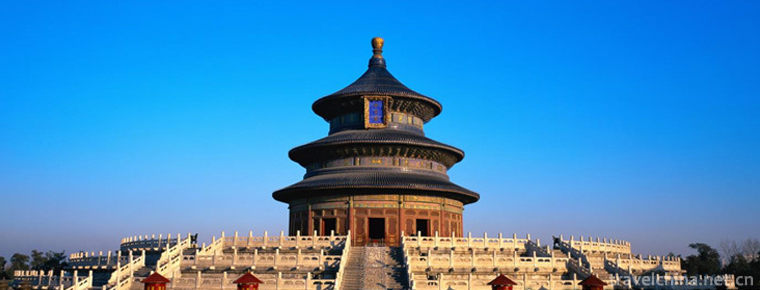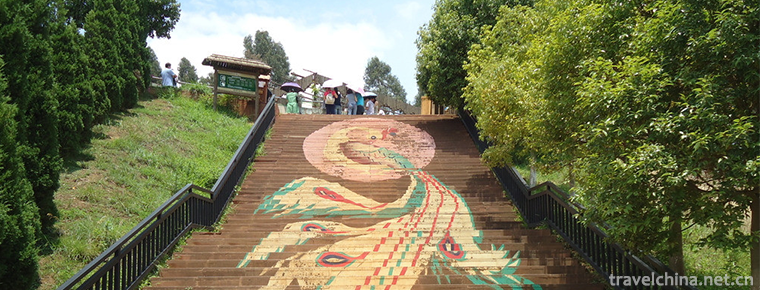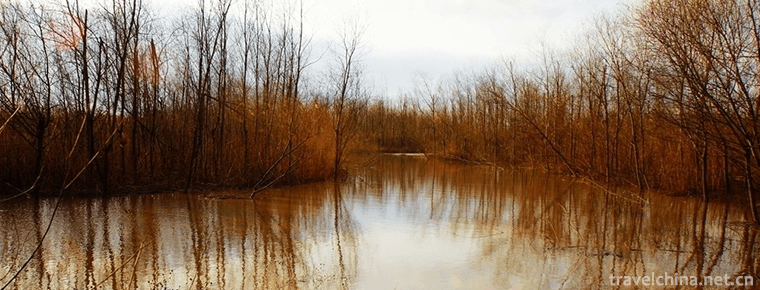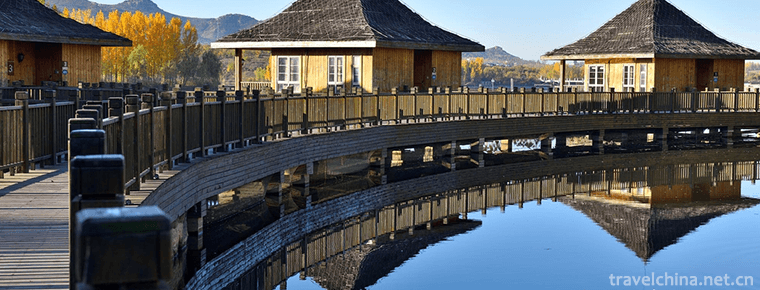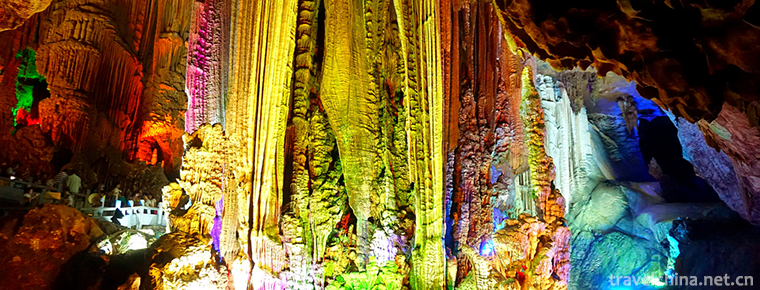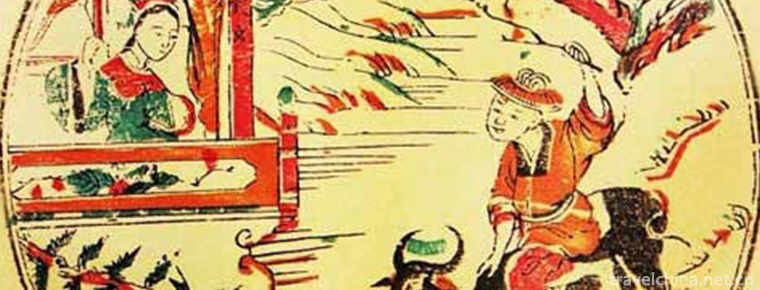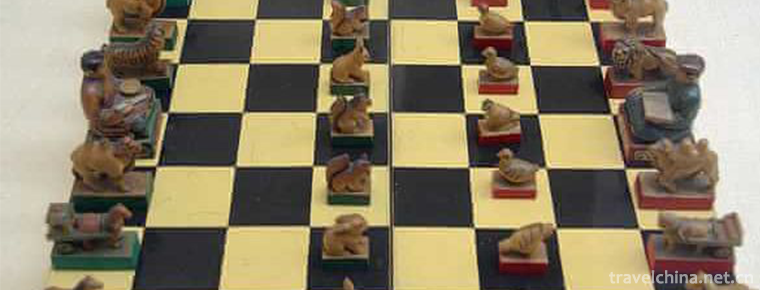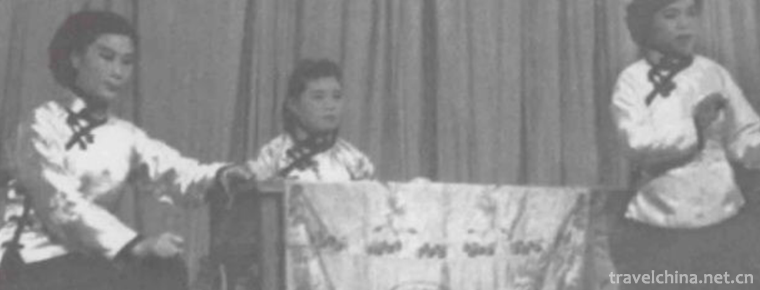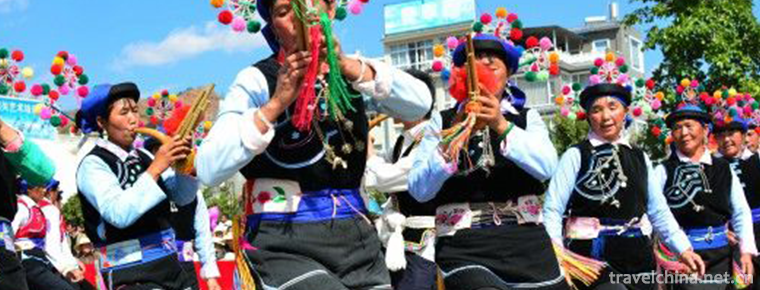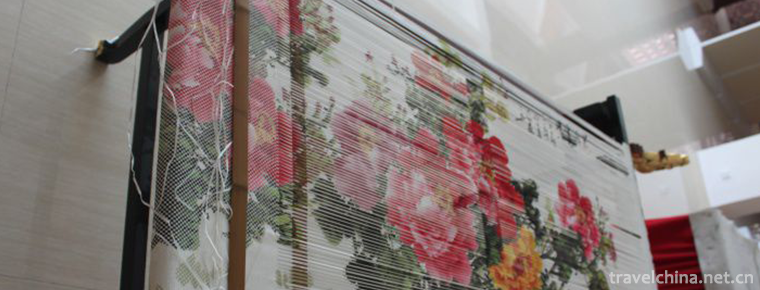Nau Song of Jingpo Ethnic Group
Nau Song of Jingpo Ethnic Group
The Jingpo Munao Longitudinal Song is the most solemn traditional national festival of the Jingpo nationality and one of the national intangible cultural heritages.
Mu Nao Song, also known as "General Ge", means "happy gathering, singing and dancing", which is popular in Jingpo ethnic community of Dehong Dai Autonomous Prefecture, Yunnan Province. Mu Nao Song Festival is the most grand traditional festival of Jingpo nationality. Tens of thousands of people are dancing on the same drum. It is a national Carnival in Western China. It has the reputation of "Dance of Paradise" and "Carnival Dance of Tens of Thousands of People". "Mu Nao" is a Jingpo language, and "Song" is a literal translation of Zaiwa language, meaning everyone dances together. In the Jingpo Nationality Settlement of Dehong Prefecture, around the 15th day of January every year is Munao Longko Festival, which is held in villages and villages.
On May 20, 2006, the "Jingpo Minority Nau Song" declared by Longchuan County, Yunnan Province, was listed in the first batch of national intangible cultural heritage list with the approval of the State Council.
historical origin
In the folklore of Jingpo Nationality, the production of Munao Longitudinal Song is as old as the origin of human beings. Legend has it that in ancient times, the song of Mu Nao was a dance in the Sun Palace. Human beings could not dance, only the sons and daughters of the Sun King would dance. The Sun King Zhanwanengsang sent messenger Bi Zuorei soup, which is the present generation. He invited the creatures on the ground to participate in the song of Munao, which was held by the Sun Palace in Bengali. All the birds on the earth were invited to the meeting. The birds and the gods of the Sun Palace danced together and gave the dance to human beings.
In the long history of Jingpo's development, the primitive religious sacrifice has been running through. With the development of history and the change of culture, the religious sacrifice activities of Jingpo are also carried out by simplified and primitive Danube Songs, which can only be held by nobles and officials. Moreover, the process of holding Danube Songs is extremely complex and the time required for activities is relatively long. In terms of sacrificial activities alone, the activities of Jingpo's religious sacrifice are alive. Since the founding of the People's Republic of China, the feudal activities of Rinao Longitudinal Song have evolved into cultural and entertainment activities, and the ritual of sacrifice has also been simplified. The recitation of sacrificial words replaced the singing of epic poems, reduced the methods of animal sacrifice, and eliminated some tedious sacrificial processes. These practices also greatly saved human, material and financial resources.
Before 1950, Munao Longitudinal Song was a major sacrificial activity in Jingpo ethnic area. It was a solemn ceremony for sacrificing the largest heavenly ghost, Mudai. Since 1950, Munao Longko Festival has become a grand gathering for making friends, promoting friendship, conducting economic and cultural exchanges and strengthening national unity.
Main activities
China's Munao Longko Festival is the most solemn traditional national festival of Jingpo ethnic group. It is widely spread in the Jingpo ethnic community of Dehong Dai Autonomous Prefecture, Yunnan Province. The Longchuan County's Pengsheng Munao Longko Festival is a typical representative. In Jingpo language, "Mu Nao Song" means "everyone sings and dances together". Every year on the 15th and 16th of the first lunar month, pupils will usher in the busiest time of the year. People from all sides gather here to participate in the annual Man Nao Song Festival, which is what people call "rushing to swing".
The Festival lasts for four days, the first day is "swing up". The responsible person of the festival will check and verify the "swing up" two days smoothly, such as the atmosphere layout of the venue, guests'hospitality gifts, the inspection of musical instruments and equipment, etc. Some vendors will make final repairs to the shelters built several days in advance in their own areas. Then start to prepare for their busy business tomorrow in advance.
The second day and the third day are "positive pendulum", which is also the most lively two days of Munao Longko Festival. The next morning, the opening ceremony was held, and the cow-plagiarism ceremony completed by the priests was over. Fireworks and cannons sounded, indicating the official start of the festival. The most important and attractive ceremony is "Munao Longitudinal Singing and Dancing". With the sounds of drums, gongs and various Jingpo songs broadcast on the festival special, people who lined up early entered the dance hall together with four elders in two columns, wearing dragon robes and peacock feathers. Four "Nao Shuang" worshiped "Munao Shidong" (with pictures of them). The map of the Nao dance route, also known as the Jingpo migration route map), was then separated from the large group, which was led by the "Nauba" of eight men and eight women in two columns, forming a huge circle. Tens of thousands of people step on the same drum and dance along the route map of ancestor migration, sometimes interlacing, sometimes encircling, advancing and retreating in an orderly manner. The formation changes with the change of drum point, without any disorder. It is a national Carnival in Western China with a huge scale and strong shock. When dancing, men and women dressed in costumes are also divided into two columns. The long silver knife in men's hands is dancing up and down, the light fan or handkerchief in women's hands is flying with the wind, and the silver bubbles on women's clothes and men's handkerchiefs are dazzling and clanking, which adds a lot of atmosphere to the festival. The dancer was completely immersed in a kind of intoxication and forgetfulness, forgetting the scorching sun, crowded people, and could not help singing "Oh..." But, oh oh, oh oh..." The scene was magnificent with the cheers. In the evening, Jingpo delegates from all jurisdictions and townships showed their own national programs written by Bai Dao, mainly including singing, dancing, sketches, and so on. They all helped to celebrate the festival.
The fourth day is "drop pendulum", which mainly holds various competitive competitions handed down from Jingpo people, such as climbing pole, twisting bamboo stick, brocade competition and so on.
Cultural characteristics
Jingpo Munao Longitudinal Song is a comprehensive art form, which integrates song, music, dance, religion, ceremony and visual performance. It belongs to a broad and profound cultural expression form in Jingpo's cultural space. "Mu Nao" is a branch language of Jingpo, and "Song" is a branch language of Zaiwa. Together, it means "everyone dances". Mu Nao Song Festival is the most grand traditional festival of Jingpo. Combining field investigation and literature, it can be seen that there are eight kinds of Munao longitudinal songs in Jingpo traditional customs, which have different cultural meanings, but they are all developed from Jingpo myths and legends, primitive religious beliefs, military agricultural sacrifices, daily prayers and so on. The most grand Munao longitudinal songs held in modern times mostly belong to the comprehensive meaning of the Mannao longitudinal songs.
The meaning of Jingpo Dangmu Nao Longitudinal Song is to pray for God to bless all things smooth, safe and happy, six animals thriving, five grain plentiful, unity and progress, national prosperity and development.
Inheritance and protection
Inheritance value
During the whole ceremony of "Munao Song", Jingpo people pursued the cultural and historical traces of Jingpo on "Munao Shidong". The Mu Nao Song, a collection of various mysterious cultural symbols woven according to a certain procedure, almost contains the most important content of the traditional culture of Jingpo people.
1. Inheritance and development of the traditional culture of the nation.
Historically, Jingpo people had no written language of their own ethnic group. Until the end of the 19th century, the Western missionary Johnson and his wife created a set of Jingpo characters spelled in Latin letters. In other words, as far as the inheritance and development of Jingpo culture is concerned, it is undoubtedly an important way and an effective way to carry out traditional culture education in this grand gathering of the whole nation. As far as the traditional Munao chanting ceremony is concerned, on the one hand, the highest-ranking Jingpo scholar, Zhaiwa, sits in the altar of Sun God beside Munao Shidong to recite the large-scale Jingpo epic of creation, Lebao Zhai Wa, for the vast majority of Jingpo people; on the other hand, the leading dancer, Nao Shuang, besides dancing the basic dance, also dances the agricultural production dance to impart knowledge of agricultural production. On this particular occasion, through the words and deeds of the highly respected Jingpo cultural personages, the vast majority of Jingpo people have acquired knowledge and culture.
2. Munao Song Festival has the consciousness of strengthening ancestor worship.
The spiral, ripple and cyclotron patterns on Munao Shidong vividly describe the Jingpo ancestors'great migration to the south for the sake of the tribe's survival and development and for the sake of "finding a good place", traveling through Jinsha River, Yalong River, Nu River, Lancang River, Mailikai River, Enmeikai River and Irrawaddy River for the reasons of climate, environmental and ecological carrying capacity and war. Wait for the valley, experienced a long, tortuous and bitter migration road. These patterns are not only the image of Jingpo ancestors migrating from the Himalayas through mountains and rivers to the south, but also the dance step road map of Jingpo descendants following their ancestors'footprints. Through this kind of worship activities, the members of Jingpo nationality have strengthened their consciousness of recognizing their ancestors and returning to their ancestors.
3. Munao Song Festival has become a link to promote communication and exchange among members of Jingpo tribes.
Jingpo ethnic group is a cross-border and resident ethnic group. Even in today's more developed civilization, it can strengthen ethnic relations, even international relations, by means of emotional communication and exchanges among ethnic groups. For example, the International Munao Song Festival held in Dehong in 2010 invited representatives of Jingpo ethnic group in China, mainly from Nujiang and Lincang areas. At the same time, representatives of Jingpo ethnic group abroad were also invited, mainly from cross-border Myanmar (which calls itself Kachin ethnic group in Myanmar). In addition, there were minority representatives of Jingpo ethnic group from India and Thailand.
Inheriting characters
Yue Matong, male, Jingpo nationality, Yunnan Province. In June 2009, Yue Matong was selected as the representative successor of the third batch of state-level intangible cultural heritage projects and declared in Longchuan County, Yunnan Province.
social influence
On February 6, 2012, two world records, the world's largest Jingpo 1000-person sword dance and the world's largest Jingpo 1000-person dance, were born in the "2012 Jingpo International Munao Song Festival" in Dehong, China.
On February 22, 2016, the opening ceremony of the 2016 China Dehong Jingpo International Munao Song Festival was held in Mangcheng City, Dehong Dai Autonomous Prefecture, Yunnan Province. Jingpo people welcomed the guests of the Eight Parties with a featured "Green Leaf Banquet". Over 3391 people attended the banquet, setting a world record of "the most numerous green leaf banquet of Jingpo people in the world".

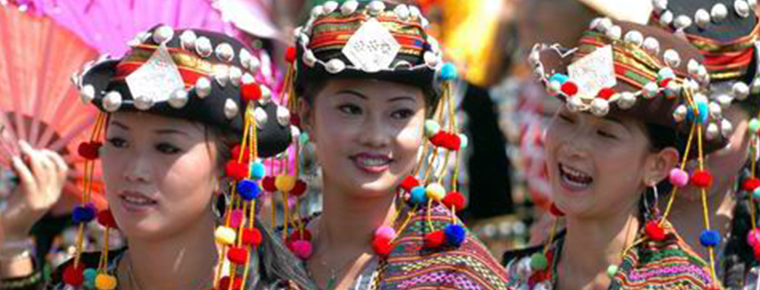
-
Tiantan Park
No. 1 donglijia, Tiantan, Dongcheng District, Beijing, China.
Views: 428 Time 2018-10-02 -
Yunnan Wildlife Park
Yunnan Wildlife Park is located in Qingshuihe Village, Fengyuan Road, Panlong District, Kunming City (beside Yunnan Forestry Department), 10 kilometers from the urban center of Kunming City.
Views: 194 Time 2018-12-22 -
Xisha Wetland of Pearl Lake
Located in Luhua Town, west of Chongming Island, Shanghai Mingzhu Lake is the largest natural inland lake on the island. It is also the main area of western water recreation .
Views: 156 Time 2019-02-07 -
Eco health Tourism Resort in Sishui Shandong Province
"Shandong Sishui Violent Eco-health Tourism Resort" is a pioneer in China, which combines superior ecological environment, long-standing health culture and modern leisure and vacation indust.
Views: 218 Time 2019-02-13 -
Silver Cave
Yinzi karst cave is a typical karst landform, which runs through 12 peaks and belongs to floor-type karst cave. The cave contains stalactites developed in different geological ages.
Views: 128 Time 2019-03-04 -
Legend of Boya Period
"When the evidence of the legendary place of Bo Yazi Period was found in Hanyang, I knew that it was hopeful to apply for the national level!" Yesterday, the reporter learned from the Provin.
Views: 210 Time 2019-04-04 -
Foshan Wood Engraving New Year Pictures
Foshan woodcut New Year's picture is a famous folk New Year's picture in South China and a wonderful flower of Lingnan traditional folk culture. It is as famous as the New Year.
Views: 175 Time 2019-04-29 -
Shatar Mongolian chess
Mongolian chess is a popular folk sports game in Inner Mongolia. Generally speaking, there are two types of Mongolian chess, one is Shatar with 8 x 8 squares on the chessboard, the other is Hayashatar.
Views: 189 Time 2019-06-03 -
Wulin Diao
Wulin Diao evolved from the folk propaganda of Baojuan and formed in the late Qing Dynasty. The performance form of Wulin tune is mainly sitting and singing, which combines narrative and singing. One .
Views: 386 Time 2019-06-30 -
The Yi Nationality Plays Songs
The dance of the Yi nationality is colorful and varied. It is typical of the simple collective dance "Da Song" (also known as "Ta Song") with the entertainment of the masses. In Mi.
Views: 116 Time 2019-07-12 -
Yongchun Paper Weaving Painting
"Yongchun County Chronicle" records: "In the early Tang Dynasty, Yongchun had the production of paper-woven paintings. Yongchun paper weaving painting features: interwoven paper marks, .
Views: 170 Time 2019-07-14 -
Historical evolution of Suining
In Xia and Shang Dynasties, Shu nationality gradually developed and distributed in Sichuan Basin. During the spring and Autumn period and the Warring States period, the Shu nationality .
Views: 192 Time 2020-12-16
